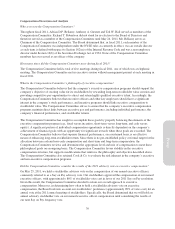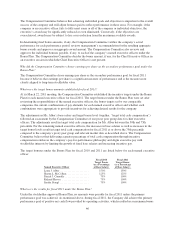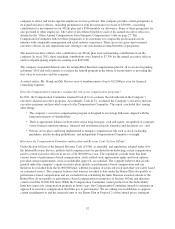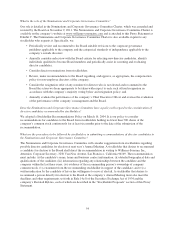Pottery Barn 2011 Annual Report Download - page 145
Download and view the complete annual report
Please find page 145 of the 2011 Pottery Barn annual report below. You can navigate through the pages in the report by either clicking on the pages listed below, or by using the keyword search tool below to find specific information within the annual report.
award’s grant date subject to the company achieving positive net cash flow provided by operating activities in
fiscal 2011 (excluding any non-recurring charges) as provided on our consolidated statements of cash flows, with
adjustments to any evaluation of performance to exclude (i) any extraordinary non-recurring items as described
in management’s discussion and analysis of financial condition and results of operations appearing in the
company’s annual report to stockholders for the applicable year, or (ii) the effect of any changes in accounting
principles affecting the company’s or a business unit’s reported results and subject to the named executive
officer’s continued service to the company through such date. The stock-settled stock appreciation rights granted
to the named executive officers vest in equal annual installments over the four-year period from the date of grant,
subject to the named executive officer’s continued service with the company.
When are equity awards made to named executive officers?
In general, equity awards to named executive officers are approved at scheduled Compensation Committee
meetings. Executives do not have any role in selecting the grant date of equity awards. The grant date of equity
awards may be a date set in advance by the Compensation Committee or the date of the Compensation
Committee’s approval. The exercise price of stock options or stock-settled stock appreciation rights is always the
closing price of the company’s common stock on the trading day prior to the grant date.
In general, equity awards to named executive officers are made during the Compensation Committee’s March
meeting in which the Compensation Committee reviews company performance over the past fiscal year and
determines base salaries and bonuses for named executive officers. The Compensation Committee also makes
equity awards at other times during the year in connection with promotions, assumptions of additional
responsibilities and other considerations, such as special retention or incentive concerns. Grants made by the
Incentive Award Committee are made in the first week of each open trading window on an as-needed basis. The
Compensation Committee does not time equity grants to take advantage of anticipated or actual changes in the
price of our common stock prior to or following the release of material information regarding the company.
Does the company have a stock ownership policy for its executive officers?
Yes, beginning in fiscal 2011, the Compensation Committee approved an Executive Share Ownership Policy for
all executives at the level of Executive Vice President and above and all executives who are required to file
reports with the U.S Securities & Exchange Commission, or SEC, under Section 16(a) of the Securities Exchange
Act of 1934. The Compensation Committee believes that an Executive Share Ownership Policy supports the
company’s objective of creating value for its stockholders by aligning the executives’ interests directly with
those of the company’s stockholders.
Under the Share Ownership Policy, the Chief Executive Officer is expected to accumulate and hold a number of
shares of the Company’s common stock equal to that number of shares with a value equal to three times annual
base salary and to maintain this minimum amount of stock ownership throughout employment. The company’s
other executives are expected to accumulate and hold a number of shares of the company’s common stock equal
to that number of shares with a value equal to one times annual base salary and to maintain this minimum amount
of stock ownership throughout employment.
The following equity holdings qualify toward satisfaction of the guidelines listed above: shares directly owned
by the executive or his or her immediate family members; shares held in trust, limited partnerships, or similar
entities for the benefit of the executive or his or her immediate family members; and shares held in Williams-
Sonoma’s qualified and non-qualified retirement plans, including shares held in the Williams-Sonoma, Inc.
401(k) Plan. Unexercised stock appreciation rights, unexercised stock options and unvested restricted stock units
or other full-value awards do not count towards satisfying the guidelines listed above.
Executives covered under the Share Ownership Policy will be required to retain an amount equal to 50% of the
net after-tax shares received as a result of the vesting of restricted stock units until the applicable guideline has
been achieved.
49
Proxy
























